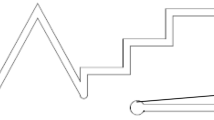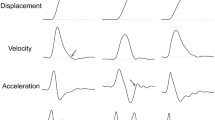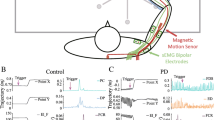Abstract
Velocity irregularities frequently observed during deceleration of arm movements have usually been interpreted as corrective submovements that improve motion accuracy. This hypothesis is re-examined here in application to movements of Parkinson’s disease (PD) patients in which submovements are specifically frequent. Pointing movements in patients and age-matched controls to large and small targets in three movement modes were studied. The modes were discrete (stop on the target), continuous (reverse on the target), and passing (stop after crossing the target). Two types of submovements were distinguished, gross and fine. In both groups, gross submovements were more frequent during the discrete and passing than continuous mode, specifically for large targets. This suggested that gross submovements were fluctuations accompanying motion termination (stabilization at the target) that was included in discrete and passing but not continuous movements. Gross submovements were specifically frequent in patients, suggesting that PD causes deficiency in smooth motion termination. Although in both groups fine submovements were more frequent for small than large targets, this relation was also observed in passing movements after crossing the target, i.e., when no corrections were needed. This result, together with higher jerk of the entire trajectory found for smaller targets, indicates that fine submovements may also be not corrective adjustments but rather velocity fluctuations emerging due to low speed of movements to small targets. This interpretation is consistent with the recognized inability of PD patients to promptly change generated force as well as to quickly re-plan current motion. The results suggest a need to re-examine the traditional interpretation of submovements in PD and the related theory that the production of iterative submovements is a strategy used by patients to compensate for a decreased initial force pulse.






Similar content being viewed by others
References
Abrams RA, Pratt J (1993) Rapid aimed limb movements: differential effects of practice on component submovements. J Mot Behav 25:288–298
Adamovich SV, Berkinblit MB, Hening W, Sage J, Poizner H (2001) The interaction of visual and proprioceptive inputs in pointing to actual and remembered targets in Parkinson’s disease. Neuroscience 104:1027–1041
Agostino R, Berardelli A, Formica A, Accornero N, Manfredi M (1992) Sequential arm movements in patients with Parkinson’s disease, Huntington’s disease and dystonia. Brain 115(Pt 5):1481–1495
Almeida QJ, Wishart LR, Lee TD (2003) Disruptive influences of a cued voluntary shift on coordinated movement in Parkinson’s disease. Neuropsychologia 41:442–452
Bellgrove MA, Phillips JG, Bradshaw JL, Gallucci RM (1998) Response (re-)programming in aging: a kinematic analysis. J Gerontol A Biol Sci Med Sci 53:M222–M227
Benecke R, Rothwell JC, Dick JP, Day BL, Marsden CD (1987) Simple and complex movements off and on treatment in patients with Parkinson’s disease. J Neurol Neurosurg Psychiatry 50:296–303
Berardelli A, Hallett M, Rothwell JC, Agostino R, Manfredi M, Thompson PD, Marsden CD (1996) Single-joint rapid arm movements in normal subjects and in patients with motor disorders. Brain 119:661–674
Berthier NE (1996) Learning to reach: a mathematical model. Dev Psychol 32:811–823
Burdet E, Milner TE (1998) Quantization of human motions and learning of accurate movements. Biol Cybern 78:307–318
Calne DB, Snow BJ, Lee C (1992) Criteria for diagnosing Parkinson’s disease. Ann Neurol 32(suppl):S125–S127
Carnahan H, Vandervoort AA, Swanson LR (1993) The influence of aging on motor skill learning. In: Stelmach GE, Homberg V (eds) Sensorimotor impairments in the elderly. Kluwer, Dordrecht, pp 41–56
Castiello U, Bennett KM (1994) Parkinson’s disease: reorganization of the reach to grasp movement in response to perturbation of the distal motor patterning. Neuropsychologia 32:1367–1382
Chua R, Elliott D (1993) Visual regulation of manual aiming. Hum Mov Sci 12:365–401
Cools AR, van den Bercken JH, Horstink MW, van Spaendonck KP, Berger HJ (1984) Cognitive and motor shifting aptitude disorder in Parkinson’s disease. J Neurol Neurosurg Psychiatry 47:443–453
Crossman ER, Goodeve PJ (1983) Feedback control of hand-movement and Fitts’ Law. Q J Exp Psychol A 35:251–278
Curra A, Berardelli A, Agostino R, Modugno N, Puorger CC, Accornero N, Manfredi M (1997) Performance of sequential arm movements with and without advance knowledge of motor pathways in Parkinson’s disease. Mov Disord 12:646–654
Darling WG, Cooke JD, Brown SH (1989) Control of simple arm movements in elderly humans. Neurobiol Aging 10:149–157
Desmurget M, Gaveau V, Vindras P, Turner RS, Broussolle E, Thobois S (2004) On-line motor control in patients with Parkinson’s disease. Brain 127:1755–1773
Doan J, Whishaw IQ, Pellis SM, Suchowersky O, Brown LA (2006) Motor deficits in Parkinsonian reaching: dopa-sensitivity influenced by real-world task constraint. J Mot Behav 38:45–59
Doeringer JA, Hogan N (1998) Intermittency in preplanned elbow movements persists in the absence of visual feedback. J Neurophysiol 80:1787–1799
Dounskaia N, Wisleder D, Johnson T (2005a) Influence of biomechanical factors on substructure of pointing movements. Exp Brain Res 164:505–516
Dounskaia N, Ketcham CJ, Leis BC, Stelmach GE (2005b) Disruptions in joint control during drawing arm movements in Parkinson’s disease. Exp Brain Res 164:311–322
Elliott D, Helsen WF, Chua R (2001) A century later: Woodworth’s (1899) two-component model of goal-directed aiming. Psychol Bull 127:342–357
Enoka RM, Christou EA, Hunter SK, Kornatz KW, Semmler JG, Taylor AM, Tracy BL (2003) Mechanisms that contribute to differences in motor performance between young and old adults. J Electromyogr Kinesiol 13:1–12
Fahn S, Elton RL (1987) Unified Parkinson’s disease rating scale. In: Fahn S, Marsden CD, Calne DB, Goldstein M (eds) Recent developments in Parkinson’s disease, vol 2. MacMillan Health Care Information, New Jersey, pp 153–163
Fitts PM (1954) The information capacity of the human motor system in controlling the amplitude of movement. J Exp Psychol 47:381–391
Flash T, Inzelberg R, Schechtman E, Korczyn AD (1992) Kinematic analysis of upper limb trajectories in Parkinson’s disease. Exp Neurol 118:215–226
Flowers K (1978a) Lack of prediction in the motor behaviour of Parkinsonism. Brain 101:35–52
Flowers K (1978b) Some frequency response characteristics of Parkinsonism on pursuit tracking. Brain 101:19–34
Folstein MF, Folstein SE, McHugh PR (1975) “Mini-mental state”. A practical method for grading the cognitive state of patients for the clinician. J Psychiatr Res 12:189–198
Fradet L, Lee G, Dounskaia N (2008) Origins of submovements during pointing movements. Acta Psychol (Amst) 129:91–100
Galganski ME, Fuglevand AJ, Enoka RM (1993) Reduced control of motor output in a human hand muscle of elderly subjects during submaximal contractions. J Neurophysiol 69:2108–2115
Giladi N, McMahon D, Przedborski S, Flaster E, Guillory S, Kostic V, Fahn S (1992) Motor blocks in Parkinson’s disease. Neurology 42:333–339
Giladi N, Kao R, Fahn S (1997) Freezing phenomenon in patients with parkinsonian syndromes. Mov Disord 12:302–305
Godaux E, Koulischer D, Jacquy J (1992) Parkinsonian bradykinesia is due to depression in the rate of rise of muscle activity. Ann Neurol 31:93–100
Gribble PL, Mullin LI, Cothros N, Mattar A (2003) Role of cocontraction in arm movement accuracy. J Neurophysiol 89:2396–2405
Guiard Y (1993) On Fitts’s and Hooke’s laws: simple harmonic movement in upper-limb cyclical aiming. Acta Psychol (Amst) 82:139–159
Hallett M, Khoshbin S (1980) A physiological mechanism of bradykinesia. Brain 103:301–314
Hoehn MM, Yahr MD (1967) Parkinsonism: onset, progression and mortality. Neurology 17:427–442
Hoffman JD (2001) Numerical methods for engineers and scientists. CRC Press, Boca Raton
Houk JC, Bastianen C, Fansler D, Fishbach A, Fraser D, Reber PJ, Roy SA, Simo LS (2007) Action selection and refinement in subcortical loops through basal ganglia and cerebellum. Philos Trans R Soc Lond B Biol Sci 362:1573–1583
Jordan N, Sagar HJ, Cooper JA (1992) A component analysis of the generation and release of isometric force in Parkinson’s disease. J Neurol Neurosurg Psychiatry 55:572–576
Kato M, Kimura M (1992) Effects of reversible blockade of basal ganglia on a voluntary arm movement. J Neurophysiol 68:1516–1534
Keele SW (1968) Movement control in skilled motor performance. Psychol Bull 70:387–403
Keijsers NL, Admiraal MA, Cools AR, Bloem BR, Gielen CC (2005) Differential progression of proprioceptive and visual information processing deficits in Parkinson’s disease. Eur J NeuroSci 21:239–248
Kelly VE, Bastian AJ (2005) Antiparkinson medications improve agonist activation but not antagonist inhibition during sequential reaching movements. Mov Disord 20:694–704
Ketcham CJ, Hodgson TL, Kennard C, Stelmach GE (2003) Memory-motor transformations are impaired in Parkinson’s disease. Exp Brain Res 149:30–39
Khan MA, Franks IM (2003) Online versus offline processing of visual feedback in the production of component submovements. J Mot Behav 35:285–295
Klockgether T, Dichgans J (1994) Visual control of arm movement in Parkinson’s disease. Mov Disord 9:48–56
Klockgether T, Borutta M, Rapp H, Spieker S, Dichgans J (1995) A defect of kinesthesia in Parkinson’s disease. Mov Disord 10:460–465
Kornatz KW, Christou EA, Enoka RM (2005) Practice reduces motor unit discharge variability in a hand muscle and improves manual dexterity in old adults. J Appl Physiol 98:2072–2080
Krebs HI, Aisen ML, Volpe BT, Hogan N (1999) Quantization of continuous arm movements in humans with brain injury. Proc Natl Acad Sci USA 96:4645–4649
Meulenbroek RG, Thomassen AJ (1993) Exploitation of elasticity as a biomechanical property in the production of graphic stroke sequences. Acta Psychol (Amst) 82:313–327
Meulenbroek RG, Vinter A, Desbiez D (1998) Exploitation of elasticity in copying geometrical patterns: the role of age, movement amplitude, and limb-segment involvement. Acta Psychol (Amst) 99:329–345
Meyer DE, Abrams RA, Kornblum S, Wright CE, Smith KJE (1988) Optimality in human motor performance: ideal control of rapid aimed movements. Psychol Rev 95:340–370
Milner TE (1992) A model for the generation of movements requiring endpoint precision. Neuroscience 49:487–496
Montgomery EB Jr, Nuessen J, Gorman DS (1991) Reaction time and movement velocity abnormalities in Parkinson’s disease under different task conditions. Neurology 41:1476–1481
Moore AP (1987) Impaired sensorimotor integration in parkinsonism and dyskinesia: a role for corollary discharges? J Neurol Neurosurg Psychiatry 50:544–552
Novak KE, Miller LE, Houk JC (2000) Kinematic properties of rapid hand movements in a knob turning task. Exp Brain Res 132:419–433
Novak KE, Miller LE, Houk JC (2002) The use of overlapping submovements in the control of rapid hand movements. Exp Brain Res 144:351–364
Osu R, Kamimura N, Iwasaki H, Nakano E, Harris CM, Wada Y, Kawato M (2004) Optimal impedance control for task achievement in the presence of signal-dependent noise. J Neurophysiol 92:1199–1215
Pasalar S, Roitman AV, Ebner TJ (2005) Effects of speeds and force fields on submovements during circular manual tracking in humans. Exp Brain Res 163:214–225
Pfann KD, Buchman AS, Comella CL, Corcos DM (2001) Control of movement distance in Parkinson’s disease. Mov Disord 16:1048–1065
Phillips JG, Martin KE, Bradshaw JL, Iansek R (1994) Could bradykinesia in Parkinson’s disease simply be compensation? J Neurol 241:439–447
Plamondon R (1995) A kinematic theory of rapid human movements. Part I. Movement representation and generation. Biol Cybern 72:295–307
Plotnik M, Flash T, Inzelberg R, Schechtman E, Korczyn AD (1998) Motor switching abilities in Parkinson’s disease and old age: temporal aspects. J Neurol Neurosurg Psychiatry 65:328–337
Poizner H, Fookson OI, Berkinblit MB, Hening W, Feldman G, Adamovich S (1998) Pointing to remembered targets in 3-D space in Parkinson’s disease. Motor Control 2:251–277
Pratt J, Abrams RA (1996) Practice and component submovements: the roles of programming and feedback in rapid aimed limb movements. J Mot Behav 28:149–156
Pratt J, Chasteen AL, Abrams RA (1994) Rapid aimed limb movements: age differences and practice effects in component submovements. Psychol Aging 9:325–334
Rand MK, Stelmach GE, Bloedel JR (2000) Movement accuracy constraints in Parkinson’s disease patients. Neuropsychologia 38:203–212
Rickards C, Cody FW (1997) Proprioceptive control of wrist movements in Parkinson’s disease. Reduced muscle vibration-induced errors. Brain 120(Pt 6):977–990
Robichaud JA, Pfann KD, Comella CL, Corcos DM (2002) Effect of medication on EMG patterns in individuals with Parkinson’s disease. Mov Disord 17:950–960
Rohrer B, Hogan N (2006) Avoiding spurious submovement decompositions II: a scattershot algorithm. Biol Cybern 94:409–414
Rohrer B, Fasoli S, Krebs HI, Volpe B, Frontera WR, Stein J, Hogan N (2004) Submovements grow larger, fewer, and more blended during stroke recovery. Motor Control 8:472–483
Roitman AV, Massaquoi SG, Takahashi K, Ebner TJ (2004) Kinematic analysis of manual tracking in monkeys: characterization of movement intermittencies during a circular tracking task. J Neurophysiol 91:901–911
Romero DH, Van Gemmert AW, Adler CH, Bekkering H, Stelmach GE (2003) Altered aiming movements in Parkinson’s disease patients and elderly adults as a function of delays in movement onset. Exp Brain Res 151:249–261
Scheidt RA, Ghez C (2007) Separate adaptive mechanisms for controlling trajectory and final position in reaching. J Neurophysiol 98:3600–3613
Schmidt RA, Zelaznik H, Hawkins B, Frank JS, Quinn JT Jr (1979) Motor-output variability: a theory for the accuracy of rapid motor acts. Psychol Rev 47:415–451
Seidler-Dobrin RD, He J, Stelmach GE (1998) Coactivation to reduce variability in the elderly. Motor Control 2:314–330
Selen LP, Beek PJ, van Dieen JH (2006) Impedance is modulated to meet accuracy demands during goal-directed arm movements. Exp Brain Res 172:129–138
Sheridan M, Flowers K (1990) Movement variability and bradykinesia in Parkinson’s disease. Brain 113:1149–1161
Sheridan MR, Flowers KA, Hurrell J (1987) Programming and execution of movement in Parkinson’s disease. Brain 110(Pt 5):1247–1271
Smits-Engelsman BC, Van Galen GP, Duysens J (2002) The breakdown of Fitts’ law in rapid, reciprocal aiming movements. Exp Brain Res 145:222–230
Teasdale N, Phillips J, Stelmach GE (1990) Temporal movement control in patients with Parkinson’s disease. J Neurol Neurosurg Psychiatry 53:862–868
Teulings HL, Contreras-Vidal JL, Stelmach GE, Adler CH (1997) Parkinsonism reduces coordination of fingers, wrist, and arm in fine motor control. Exp Neurol 146:159–170
Thelen E, Corbetta D, Kamm K, Spencer JP, Schneider K, Zernicke RF (1993) The transition to reaching: mapping intention and intrinsic dynamics. Child Dev 64:1058–1098
Tunik E, Poizner H, Adamovich SV, Levin MF, Feldman AG (2004) Deficits in adaptive upper limb control in response to trunk perturbations in Parkinson’s disease. Exp Brain Res 159:23–32
Vaillancourt DE, Larsson L, Newell KM (2003) Effects of aging on force variability, single motor unit discharge patterns, and the structure of 10, 20, and 40 Hz EMG activity. Neurobiol Aging 24:25–35
Walker N, Philbin DA, Fisk AD (1997) Age-related differences in movement control: adjusting submovement structure to optimize performance. J Gerontol B Psychol Sci Soc Sci 52:P40–P52
Weiss P, Stelmach GE, Hefter H (1997) Programming of a movement sequence in Parkinson’s disease. Brain 120(Pt 1):91–102
Wisleder D, Dounskaia N (2007) The role of different submovement types during pointing to a target. Exp Brain Res 176:132–149
Woodworth RS (1899) The accuracy of voluntary movement. Psychol Rev 3:1–119
Acknowledgment
The study was supported by NINDS NS 43502 and by ASU/Mayo Seed Grant.
Author information
Authors and Affiliations
Corresponding author
Rights and permissions
About this article
Cite this article
Dounskaia, N., Fradet, L., Lee, G. et al. Submovements during pointing movements in Parkinson’s disease. Exp Brain Res 193, 529–544 (2009). https://doi.org/10.1007/s00221-008-1656-6
Received:
Accepted:
Published:
Issue Date:
DOI: https://doi.org/10.1007/s00221-008-1656-6




